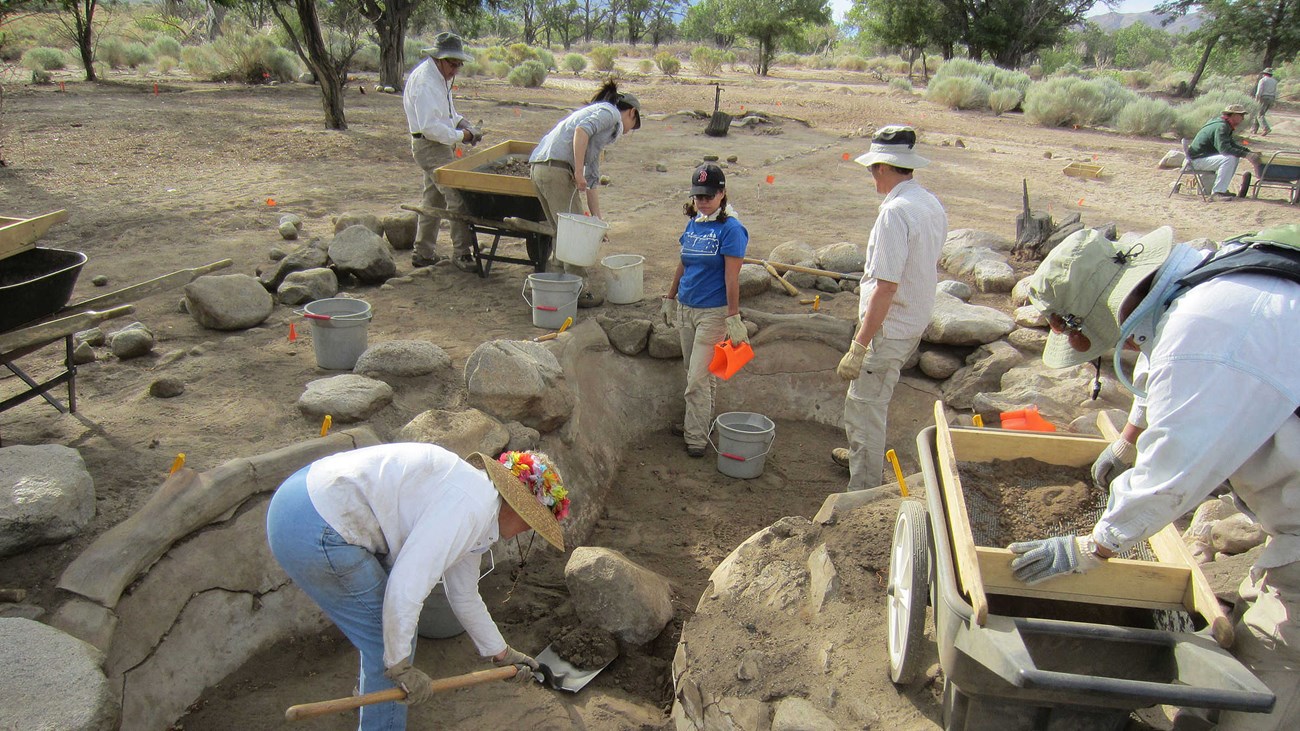Last updated: May 13, 2024
Article
Archeology This Month: Asian American and Native Hawaiian/Pacific Islander Heritage

Archeology This Month celebrates the diverse heritage of the United States and its connections around the world. For Asian American and Native Hawaiian/Pacific Islander Heritage Month in May, discover the ways that archeology reaches into the not-so-distant past to document how we know what we know about their untold stories and contributions to the nation's history.
Native Hawaiians
The Footprints Archeological Site is located in the district of Ka`ū, within the ahupua’a (traditional land unit) of Kapāpala at Hawai’i Volcanoes National Park. Around 1790, someone (or several someones) left footprints that fossilized in the volcanic ash. Archeologists have also found evidence of temporary habitation sites, petroglyphs, trails, and volcanic glass quarry areas.
Hawaiian men worked the agricultural fields and sawmills at Fort Vancouver National Historic Site, which was the colonial “Capital” of the Pacific Northwest in the 1820s-1840s. Archeological findings of their residences and activities contributes to understanding working class ethnic diversity in the upper Northwest.
Pulu factories developed in the mid-19th century on Hawai'i. The soft, downy material grows around the fronds and fiddleheads of the hāpuʻu pulu fern. Archeologists working at the Pulu Station in Hawai'i Volcanoes National Park have found evidence of a processing center.
Chinese in America
Only second-hand accounts remained of Chinese immigrants' labor on the Transcontinental Railroad after it was completed in 1869, or at least, until archeologists started asking questions. Chinese workers and their communities left artifacts and sites after they left the workers camps and settlements.
Chinese fishermen held a prominent place in the abalone industry until social discrimination, codified in various federal laws passed in the late 1800's, gradually pushed them out. Archeological features at Channel Island National Park include a hearth in a unique “hairpin” shape, which is found on Chinese campsites both on the Channel Islands and California mainland and may be a sign of a shared cultural tradition.
Between the 1880s and the 1920s, Whidbey Island was home to a Chinese community centered on Ebey’s Prairie farmlands. While the farmers welcomed their labor, the Chinese faced discrimination and harrassment by white residents. Artifacts such as medicine bottles, ceramic bowls, gaming pieces, and storage jars attest to everyday life.
Japanese American Internment
Following the attack on Pearl Harbor in 1942, the United States government ordered more than 110,000 men, women, and children to leave their homes and then detained them in ten remote, military-style camps. They included U.S. citizens of Japanese ancestry, Japanese immigrants ineligible for citizenship, and prisoners of war. Archeology, in combination with oral history, reveals what life was like in the camps.
The first Japanese Americans arrived at Manzanar in March 1942 and the last left in November 1945. By September 1942, there were over 10,000 internees. Day-to-day, they dug irrigation canals and ditches, grew fruits and vegetables and raised animals. They made clothes and furniture for themselves and camouflage netting and experimental rubber for the military. They served as mess hall workers, doctors, nurses, police officers, firefighters, and teachers. For recovering evidence of these and other stories, the Manzanar National Historic Site’s Community Archeology Program received the prestigious 2021 Award for Excellence in Public Archaeology Programming from the Society for American Archaeology (SAA).
Honouliuli opened in 1943 and closed in 1946. It was a civilian internment camp and a prisoner of war camp holding approximately 400 internees and 4,000 prisoners of war over the course of its use. The 160 acre internment camp contained 175 buildings, 14 guard towers, and over 400 tents. Internees referred to Honouliuli as Jigoku-Dani ("Hell Valley") because its secluded location in a deep gulch trapped heat and moisture and reinforced the internees' sense of isolation and unjust imprisonment. An archeological field school from the University of Hawaii - West Oahu is finding features from the Honouliuli National Historic Site.
What You Can Do
Here's are a few ways that you can help preserve, protect, and interpret archeological places that tell the stories of Asian Americans and Native Hawaiian/Pacific Islanders:
Nominate an archeological property to the National Register of Historic Places or to become a National Historic Landmark. These NHL theme studies can get you started:
- Confinement and Ethnicity: An Overview of World War II Japanese American Relocation Sites (2000) and the Japanese Americans in World War II Theme Study (2012)
- Essay 3: Archaeological Research on Asian Americans in the Asian American Pacific Islander Theme Study (2017)
Apply for a grant administered by the National Park Service:
- The Japanese American Confinement Sites Program awards grants to organizations and entities working to preserve historic Japanese American confinement sites and their history.
- The Underrepresented Community Grant Program (URC) works towards diversifying the nominations submitted to the National Register of Historic Places. URC grants are funded by the Historic Preservation Fund (HPF), and are administered by the NPS. Projects include surveys and inventories of historic properties associated with communities underrepresented in the National Register, as well as the development of nominations to the National Register for specific sites.
